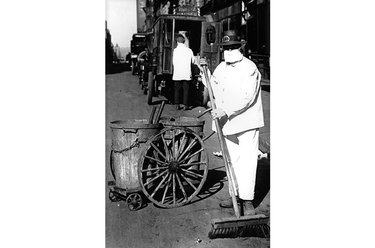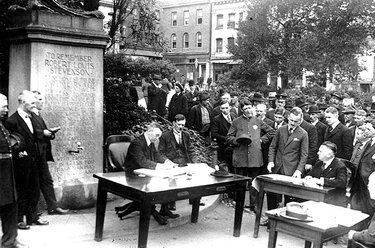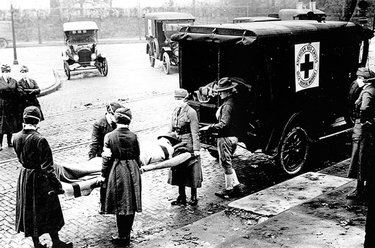Influenza came to town in 1918, closing schools and killing soldiers
— From the Centers for Disease Control and Prevention
Red Cross volunteers in Boston: Massachusetts had been drained of doctors and nurses due to calls for military service, and no longer had enough personnel to meet the civilian demand for health care during the 1918 flu pandemic. Governor Samuel Walker McCall asked every able-bodied person across the state with medical training to offer their aid in fighting the epidemic. Boston Red Cross volunteers assembled gauze influenza masks for use at hard-hit Camp Devens in Massachusetts.
— From the Centers for Disease Control and Prevention
Red Cross volunteers in Detroit: Motor Corps and Canteen volunteers from the Detroit chapter of the Red Cross take a break from delivering supplies to flu victims. To prepare Detroit for what was to come from the pandemic, the Red Cross and Department of Health nurses cooperated together for home visits, food preparation, and child care.
— From the Centers for Disease Control and Prevention
Open-air police court in San Francisco: As the number of influenza cases in San Francisco rose sharply, the City Board of Health issued a series of recommendations to the public on how to avoid contracting influenza including avoiding the use of streetcars during rush hour, avoiding crowds, and paying attention to personal hygiene. To prevent crowding indoors, judges held outdoor court sessions. The Board of Health recommended all services and socials be held in the open air, if they weren’t cancelled.
— From the Centers for Disease Control and Prevention
Ambulance duty in St. Louis: The Motor Corps of St. Louis chapter of the American Red Cross was on ambulance duty during the influenza epidemic in October 1918. The Red Cross motor corps recruited volunteer drivers and automobiles to supplement ambulances and chauffeur nurses from one quarantined house to the next. Through this volunteer system, approximately 40 nurses cared for about 3,000 patients who otherwise had no access to private nursing.
The normally pleasant days of late summer 1918 were overshadowed by an outbreak of Spanish influenza, initially affecting a naval training base near Boston, next a nearby army camp, then rapidly infecting Boston’s civilian population. Quickly reaching epidemic proportions and spreading out along the nation’s rail lines, wide swaths of the country were soon overwhelmed by the disease.
The disease originally surfaced in Spain in February 1918 as a somewhat milder form of influenza with widely scattered outbreaks over the summer, only to erupt in a second wave during the last weeks of August in a more contagious and virulent form. Not only was there a high death rate among the very young and old, unusually, a high mortality rate affected otherwise healthy 20- to 40-year-olds.
A tragic coincidence was, in late August, for the fifth year, World War I was raging in Europe. A huge military build-up had begun in this country after our declaration of war on Germany in 1917.
Since the United States had virtually no army at that time, training camps were immediately established, each housing 25,000 to 50,000 men — both volunteers and draftees — often crowded over capacity. Once training was complete, jammed troop trains transported the men to ports to be shipped to European battlefields in close quarters on troop ships, a perfect scenario for spreading the influenza virus.
Among these troops, there were many men from Guilderland and the surrounding area.
Local life as usual
As usual, life was good for most of Guilderland during August that year. Those fortunate enough to own an automobile were out on motoring trips. Others stayed close to home, visiting friends and relatives, attending church services, or socializing at meetings or events like the ice cream social at St. Mark’s in Guilderland Center.
However, it was noted in that community’s Enterprise column that, during the last week of August, five women were ill, though with no details. Otherwise, life seemed normal.
Endless local events were on tap to make September a very busy month. The Altamont Fair ran from Sept. 17 to 20 that year, on one day attracting 10,000 people. Guilderland voters gathered at the polls on Sept. 14 to vote on the local option to turn the town “dry.” A large turnout, including newly enfranchised women, cast their ballots at the only polling place at the town’s recently acquired building in Guilderland Center.
School openings, numerous church services and activities, meetings of Red Cross groups, family reunions, Saturday night movies at the Masonic Hall, the usual social calls all led to an amazing amount of social interaction among town residents. But only the Guilderland Center and Parkers Corners columns mentioned illness, again nothing specific.
However, in nearby Albany, influenza cases suddenly spiked during late September and it’s very likely many cases had begun to crop up in Guilderland unannounced in the local columns.
Most newspapers, whether weeklies like The Enterprise or city dailies, gave limited coverage of the epidemic, which by mid-September was raging not only in Boston or Philadelphia, a city that was particularly hard hit, but also in smaller cities like Albany where, by early November, 7,091 cases were reported.
Freedom of the press was limited during World War I. Federal legislation forbade any reports critical of or disloyal toward the government, anything unpatriotic, or anything that would hurt the war effort. Stiff penalties could be imposed. Papers tread carefully, fearing too much news about the epidemic would have a bad effect on morale.
Albany’s Health Officer seemed to believe it was not a serious epidemic, forcing Dr. Herman Biggs, the New York State Health Commissioner, to issue a letter to newspapers of the state on Sept. 27, 1918, asking them to warn their readership “to brace for the epidemic.” He also requested that physicians report cases of influenza and pneumonia in their locality. This message did not appear in either of the next two weeks’ editions of The Enterprise although anyone who read an Albany daily surely would have been aware of it.
Guilderland readers took notice on Oct. 4 when, at the bottom of The Enterprise’s front page, a report of a Coeyman’s soldier’s death from influenza and pneumonia appeared. That fall, he was the first of local soldiers in our immediate area to die of influenza rather than war wounds.
That same edition of The Enterprise reported that Earl Becker, stationed at the naval recruiting station in New Haven, Connecticut, came home to Altamont on a 48-hour furlough, and, having contracted Spanish influenza on his way home, was quite ill. He fortunately recovered and returned to duty.
Otherwise in Guilderland, that first week of October life went on as usual. At the Masonic Hall, a traveling stock group performed a different play each night for five successive nights, attracting large audiences. Church groups and fraternal organizations met, church services were held, and children attended school. Only the Dunnsville and Guilderland Center columns reported a small number ill, but with no mention of influenza.
Hit with a vengeance
The disease hit town with a vengeance during that week because, by the time the next week’s Enterprise was in the hands of readers, churches and schools had closed. At the bottom of page one, a short notice stated that, at the request of the Board of Health, no public gatherings could take place in Altamont for several days.
“Both of the churches will be closed all day Sunday, the movies, lodges, prayer meetings, Sunday Schools and society meetings will be discontinued on account of the prevalence of the Spanish influenza which has made its appearance here,” The Enterprise reported. According to the notice, only a few cases had been reported in the village and it was thought these rules would help to halt the spread of the disease.
Page five of the same edition carried a brief notice from the Surgeon-General of the United States Public Health Service that he had issued a publication dealing with the Spanish influenza, which contained all known available information regarding the disease. Anyone interested could send for the publication by mail.
In the meantime, there were already thousands dead in East Coast cities such as Philadelphia, New York, and Boston. In 1918, the federal government was not very involved with national health issues but, as the situation worsened, the Surgeon-General sent out a communique to newspapers across the nation.
Prominently headlined atop page one of the Oct. 18 Enterprise was: “Uncle Sam Gives Advice on the ‘Flu’” with the warning that “droplets” from sneezing, coughing, or even hardy laughter could infect others. It was the local officials, however, who actually stepped in to take action to prevent the spread of the disease and, in urban areas, also dealt with the huge number of deaths.
At this time, Guilderland Center’s correspondent reported, “The epidemic of grippe (the old-fashioned word for influenza) is so prevalent in our village there is scarcely a home which has not had someone ill.” Church services were cancelled as were meetings of the Red Cross, Christian Endeavor, and Sunday School lessons. The Liberty Bond Drive meeting with its out-of-town speaker also had to be cancelled because the speaker had the disease.
Although several McKownville residents had been stricken, it didn’t stop that community’s baseball team who “rung down the curtain on the season” with a dinner at Albany’s Keeler’s Restaurant. This must have taken place before Oct. 9 though, because the epidemic had become so critical in Albany that on that date everything was shut down as cases there mounted into the thousands.
Another complication of our involvement in the war was that, out on the Western Turnpike in Fullers, there were two couples under the care of Voorheesville’s Dr. Joslin. During October 1918, about 38,000 American doctors were either serving overseas — such as Guilderland Center’s Dr. Hurst — or at military training camps, placing an additional burden on the doctors remaining at home.
It was reported that, in one day that October, Dr. Joslin treated 58 influenza cases, obviously traveling far afield if he were paying house calls from Voorheesville over to Fullers.
Numerous names of influenza sufferers are mentioned in the various Enterprise columns from all parts of town, but the progress of one case described repeatedly was that of Millard Cowan, a well-known Altamont resident first reported suffering from influenza in the Village Notes column Oct. 25. He was under the care of Dr. Cullen and a trained nurse.
A week later, even though it was cited that the epidemic of influenza in Altamont had practically ceased to spread, the most serious case was Millard Cowan, “critically” ill for more than a week. Developing pneumonia as a complication, “for several days his life was in the balance. We are now informed that hopes are entertained of his recovery although it will be several days before he is out of danger of a relapse.”
The next week, Cowan was slowly recovering. “Of the many cases in this vicinity, Mr. Cowan’s was the most serious of all,” the columnist wrote. It was predicted he would be around again in a few weeks’ time.
Another week later, he was “recovering very nicely,” the columnist wrote, noting it was four weeks ago Thursday that he had come down with the illness. His nurse, Miss Hadley, left Monday, seeing he was considered out of danger. Thursday he sat up for the first time.
Cowan didn’t return to his job in Albany until the second week of January. In the meantime, his wife had received the tragic news that her brother on duty with the army in Europe had died of influenza and pneumonia.
Schools close
Schools closed at various times in various parts of town. Those that were noted suspending classes were Guilderland Center, Guilderland, Dunnsville, Meadowdale, Parkers Corners, and Fullers. Altamont’s school, which housed grades one through twelve, closed on Oct. 14.
Dr. Cullen ordered Altamont’s school to remain closed even though other activities in the village were allowed to resume. After three weeks, the school was permitted to reopen, but grades one and two and grades five and six (at that time two grades to a classroom) were dismissed on Tuesday for the remainder of that week due to sickness. Even Prof. Hook, the high school principal, had had the flu.
Flu kills soldiers
Into early November, Guilderland was fortunate that, while much of the population had had the influenza, there seemed to have been no fatalities here. However, it was reported in the Nov. 8 Meadowdale column that “a telegram was received here Saturday stating that Matthew Hennessey was seriously ill at Camp Wheeler, Ga.”
The next week, word came that Harry Mesick of Altamont “who was inducted into service about three weeks ago and sent to Camp Wheeler, Ga. with a number of other young men of this vicinity, was taken sick shortly after arrival, died last week. His body was buried near the camp. His sudden death came as a shock to his friends here, who deeply sympathize with his family.”
The next week, news came that “Matthew Hennessy died on Tuesday, November 5 at a base hospital in Georgia, age 21 years. His funeral was held at St. Matthew’s Church.” These two men and the Coeymans soldier were among the 43,000 servicemen who died in the influenza pandemic, more than the number of Americans who were killed in battle during World War I.
Winding down
During the month of November, there were still many local cases of influenza reported, but the number seemed to be winding down. December brought virtually no reports of new cases.
However, in January 1919, there were many new cases. Settles Hill farmer Walter Gray died early in the month. and a few weeks later Clarence Osterhout, age 34, died at his home in Altamont after being ill less than a week.
Then, the numbers dropped and by spring Spanish influenza seemed to have disappeared from town.
To this day, the actual origin of Spanish influenza isn’t definitely known — certainly not Spain. Some researchers claim China; others theorize it all began in Kansas.
Estimates run as high as 50 million people or more who died worldwide; of those, 675,000 were Americans. While Albany suffered over 450 deaths, Guilderland’s comparatively low mortality rate — and it’s possible there were additional deaths not listed in The Enterprise — was probably due to its rural character and cancellation of activities.




